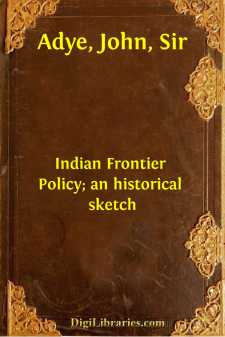Categories
- Antiques & Collectibles 13
- Architecture 36
- Art 48
- Bibles 22
- Biography & Autobiography 813
- Body, Mind & Spirit 141
- Business & Economics 28
- Children's Books 12
- Children's Fiction 9
- Computers 4
- Cooking 94
- Crafts & Hobbies 4
- Drama 346
- Education 46
- Family & Relationships 57
- Fiction 11826
- Games 19
- Gardening 17
- Health & Fitness 34
- History 1377
- House & Home 1
- Humor 147
- Juvenile Fiction 1873
- Juvenile Nonfiction 202
- Language Arts & Disciplines 88
- Law 16
- Literary Collections 686
- Literary Criticism 179
- Mathematics 13
- Medical 41
- Music 40
- Nature 179
- Non-Classifiable 1768
- Performing Arts 7
- Periodicals 1453
- Philosophy 64
- Photography 2
- Poetry 896
- Political Science 203
- Psychology 42
- Reference 154
- Religion 513
- Science 126
- Self-Help 83
- Social Science 81
- Sports & Recreation 34
- Study Aids 3
- Technology & Engineering 59
- Transportation 23
- Travel 463
- True Crime 29
Indian Frontier Policy; an historical sketch
by: John Adye
Description:
Excerpt
CHAPTER I
EVENTS PRIOR TO, AND INCLUDING, FIRST AFGHAN WAR OF 1839-41
Proposed Invasion of India by Napoleon I.—Mission of Burnes to Cabul
—Its Failure—Hostility of Russia and Persia—First Afghan War, 1839-41
—Its Vicissitudes and Collapse.
In considering the important and somewhat intricate subject of policy on the North-Western frontier of our Indian Empire it will be desirable, in the first place, to give a concise history of the events which have guided our action, and which for many years past have exercised a predominating influence in that part of our Eastern dominion.
Speaking generally, it may, I think, be said that the main features of our policy on the North-Western frontier have been determined by the gradual advance of Russia southwards, and partly also by the turbulent character of the people of Afghanistan, and of the independent tribes who inhabit the great region of mountains which lie between Russia and ourselves.
These two circumstances—the first having been the most powerful—have led us into great wars and frontier expeditions, which as a rule have been costly, and in some cases unjust, and their consequences have not tended to strengthen our position either on the frontier or in India itself.
It will be well therefore to give an outline of the Russian conquests in Central Asia to the north of Afghanistan, and also of our dealings with the rulers of Cabul in bygone years, and we shall then be better able to judge of our present position, and to determine the principles which should guide our North-Western frontier policy.
One of the first threats of invasion of India early in the century was planned at Tilsit, and is thus described by Kaye:[Footnote: History of the War in Afghanistan] 'Whilst the followers of Alexander and Napoleon were abandoning themselves to convivial pleasures, those monarchs were spending quiet evenings together discussing their future plans, and projecting joint schemes of conquest. It was then that they meditated the invasion of Hindostan by a confederate army uniting on the plains of Persia; and no secret was made of the intention of the two great European potentates to commence in the following spring a hostile demonstration—Contre les possessions de la compagnie des Indes.'
The peril, however, was averted by a treaty at Teheran in March 1809, in which the Shah of Persia covenanted not to permit any European force whatever to pass through Persia towards India, or towards the ports of that country. And so the visionary danger passed away.
The old southern boundary of Russia in Central Asia extended from the north of the Caspian by Orenburg and Orsk, across to the old Mongolian city of Semipalatinsk, and was guarded by a cordon of forts and Cossack outposts. It was about 2,000 miles in length, and [Footnote: Quarterly Review, Oct. 1865.] 'abutted on the great Kirghis Steppe, and to a certain extent controlled the tribes pasturing in the vicinity, but by no means established the hold of Russia on that pathless, and for the most part lifeless, waste.'
During all the earlier years of the century, while we were establishing our power in India, constant intrigues and wars occurred in Persia, Afghanistan, and Central Asia; and rumours were occasionally heard of threats against ourselves, which formed the subject of diplomatic treatment from time to time; but in reality the scene was so distant that our interests were not seriously affected, and it was not until 1836 that they began to exercise a powerful influence as regards our policy on the North-West frontier....


